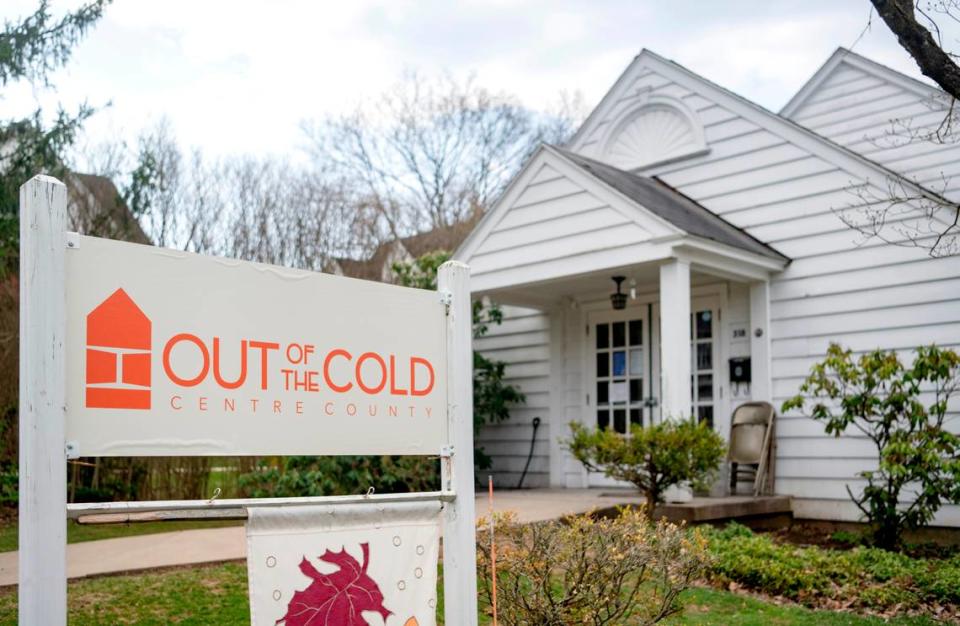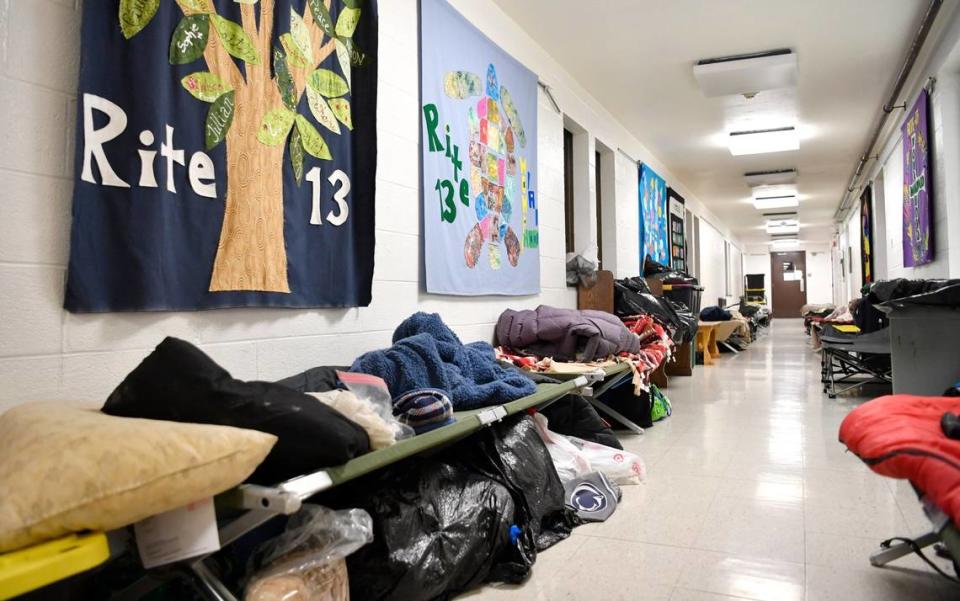Services to help homelessness in Centre County expand, but obstacles remain
Ten years ago when volunteers embarked on the annual Point-in-Time count to better understand homelessness in Centre County, Faith Ryan, director of adult services, remembers a lack of awareness to the issue.
Most communities, she said, were steadfast: “We don’t have homelessness here.”
Today, after years of PIT count numbers above 100 — with the last two years above 200 — and programs that the county continues to expand to meet a growing need, that’s no longer the case.
“The shift in awareness of homelessness and housing instability in Centre County has been drastic, even just in the past 10 years,” Ryan said.
The county’s Office of Adult Services and housing nonprofits took part in this year’s PIT count on Jan. 26. A count is taken of the sheltered or unsheltered (living or residing somewhere that is not habitable for humans, such as a car, in an RV without utility hook ups, tents, parking garages or on the street) homeless.
This year, 206 unsheltered and sheltered homeless individuals were counted, down slightly from last year’s count. The number includes 43 people in emergency shelter, 33 in transitional housing, 106 in rapid re-housing, 21 in permanent supportive housing, and three people who were unsheltered. During the count, volunteers across Centre County ask where people slept the night before.
Six teams went out during normal business hours to try to communicate with the community through businesses, convenience stores, post offices, etc., to try to identify anyone who might fit into the “literal homeless” category, Ryan said. Those numbers are then reported to the Department of Housing and Urban Development.
“For the whole calendar year 2023, I can say that there were 203 individuals that were sheltered and three that were not, or that were literally homeless. And I think that number is pretty powerful because it’s still a number that people can relate to. That’s a lot of people in their community that in some capacity don’t have anywhere to call their own home,” Ryan said.
Centre County has also utilized this day as a large outreach event. Staff and volunteers try to educate the community on what homelessness is, what programs are available, distribute literature and ask if they know anyone experiencing homelessness, or if that person is homeless, Ryan said.
It’s typical for the county to not find a large number of unsheltered individuals — it usually averages between one to four or five individuals each year. But that doesn’t mean they’re not out there.
Someone who is unsheltered, or “literally homeless,” is only counted in the PIT count if the teams actually see them. That can be frustrating, Ryan said, because the people who are working with the homeless population every day, such as Housing Transitions, Centre Safe and Out of the Cold: Centre County, oftentimes know where people are staying and where to find them, but they won’t be there the day of the count.
The teams might get leads for unsheltered individuals (17 this year) or for those with housing instability (five individuals or families this year) and check many locations. This year, they checked 165 locations during the unsheltered count across the county. By keeping track of the leads, Ryan said they’re able to “quantify what we’re not able to document.”
As part of Centre County’s PIT count this year, the Office of Adult Services and Housing Transitions added a “Centre County By-Name-List” on the night of Feb. 15, 20 days after the PIT count. This is basically a waitlist of people who have a high housing or homeless need, but there’s no place for them that night. There were 243 “literally homeless” households on that list.
“That’s that compounding issue. We have the unsheltered part where we’re trying our best to identify the people, we know we’re not capturing everybody. Sheltered is a growing number, but it’s growing because we’re expanding our programs. Our capacity is our capacity, so it’s still not fully reflective of the need, but being able to have that ‘By Name List’ is saying, so in addition to those 203 people that actually have a program, there’s 243 waiting for something, or the very least called at some point and said ‘I’m homeless,’” Ryan said.

Sheltered Count
Of the shelters in Centre County — all of which are in the State College area — some had a smaller number of sheltered individuals in the PIT count. Centre Safe and Housing Transitions each had seven individuals, for example, but Out of the Cold had 28.
Morgan Wasikonis, executive director at Housing Transitions, a nonprofit that provides housing programs and supportive services to those in need throughout Centre County, said up until the beginning of February, they were still practicing social distancing at the congregate shelter. By loosening that restriction, they’ve been able to have more people and families.
At the end of March, Wasikonis said they had 17 individuals in their shelter, which is more than they’ve been able to have in a long time because of restrictions.
“But it remains difficult to figure this out because obviously there are many more people who are experiencing homelessness than we’re able to accommodate,” Wasikonis said.
People in the transitional housing, rapid rehousing and permanent supportive housing programs — 143 total during the count — would likely be homeless without those housing support programs.
“Our case managers and those at Centre Safe are really able to assist people to really kind of get into independent housing and be able to live independently. So I think that’s just really important. The people that are in the permanent supportive housing that you see with Housing Transitions are often people who have experienced chronic homelessness who have lived on the streets, unsheltered for sometimes decades,” Wasikonis said.

Centre County’s housing authority was awarded 43 emergency housing vouchers to be allocated in 2022. With the voucher, the person pays 30% of their income in rent and the subsidy pays the remainder of the rent.
Wasikonis said those were for people who were experiencing homelessness or to help those move on from programs like Rapid Re-Housing or permanent supportive housing.
“That was a lot of people who are experiencing homelessness that aren’t even showing up on (the PIT). But then we filled out all of our programs with other people really quickly,” Wasikonis said. Some of the vouchers also went to people on the By Name List.
Taking risks to provide more
In 2022, the Office of Adult Services had a hotel Emergency Rental Assistance Program (ERAP) that was originally in response to a growing need for emergency shelter. At the time, a lot of agencies were primarily using hotel stays because they were unable to use congregate settings due to the pandemic.
Centre County began using ERAP money for hotels. At the time of the 2022 PIT count, there were 95 individuals in hotels.
“I think what was so telling about that experience is, although the guidelines were loose, and although the program was incredibly reactive, I can’t say there was ever a single person that we housed that did not have some of the highest housing barriers or just level of need,” Ryan said.
When that program came to a close at the end of 2022, agencies put a lot of effort into trying to offer permanent housing solutions for people. Some were able to find that and others weren’t, Ryan said.
The program increased the county’s typical homeless numbers by about 100 people. But this year, the number of people experiencing homelessness wasn’t that far off from last year’s number, which surprised Ryan. But a lot of that is because in addition to ERAP and the hotel program, they also received an Emergency Solution Grant related to the pandemic, which came with funds for emergency shelter and rapid rehousing programming, and they doubled the size of the rapid rehousing grant through HUD. That all created more staffing and housing opportunities, she said.
Looking forward, the county will be doing an additional Rental Assistance Program through the homeless prevention portion of the federal Emergency Solutions Grant. It is still in its infancy stage, Ryan said, and it’s the first time the county will be doing something internally at this level.
The Office of Adult Services is trying to diversify its portfolio of services. The homeless prevention rental assistance will be a little more strict than other programs but still gives people an opportunity.
“We’re taking major risks in our department because ERAP positioned us to do that, honestly. ERAP put us in a position where we’re looked at differently in the community. People reach out to us for different things. We had a different type of presence and the ability to collect data. And so we’re taking risks,” Ryan said.
Another risk they’re taking is the Whole Home Repair Program. It’s not a direct homelessness prevention program but it came down from the federal and state governments and “kind of landed in our lap,” Ryan said. The $1.3 million will allow the department to take a specific role but also to engage with Housing Transitions, the municipalities, energy efficiency groups and open up a new door to home repair and homeowners. More information on the program will be available in the near future.
The HOME Foundation, a community housing development organization that provides free supportive housing education and housing counseling services to Centre County, has also seen an increase in mortgage prevention and foreclosure prevention counseling, and has been a service that they’ve been able to grow, Wasikonis said. They’re also looking to grow the housing counseling capacity.
“We would rather keep people in their homes than have them become homeless. And so I’m trying to find ways that we can grow those programs,” Wasikonis said.
The HOME Foundation recently completed renovating an eight townhome unit building in State College and are taking pre-screening applications until April 15. They’re for low income to start with, for households below 60% of the area median income, and three of the units will be for people below 50% of the area median income. The rent will be largely based on the income of the household.
Despite the many challenges, none of it has deterred human services professionals in Centre County from trying, Ryan and Wasikonis agreed.
The community or people who are struggling and waiting for services get frustrated, understandably, Ryan said, because it can feel like there’s nothing out there.
“Unfortunately we have folks sometimes that go through all the programs, and they want to know why there’s nothing left and it’s like, because there’s an end. That said, we are still making a lot of effort to apply for things that we don’t necessarily have to, like Whole Home, ESG, we didn’t have to apply for them. But we decided to and they’re not easy programs to run at all,” Ryan said.
Wasikonis added: “We recognize that they are worth not just the dollars that we’re able to use to assist people in the county but it’s also to be able to … kind of grow that recognition of the work that we’re able to do here and continue to expand the different services as the needs evolve.”

